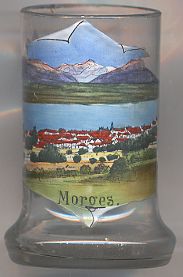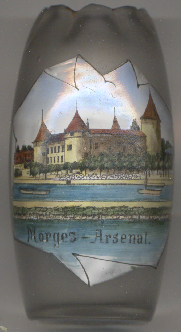

|
| SCHWEIZ / SUISSE / SVIZZERA / SVIZRA | SWITZERLAND |
| Waadt / Vaud / Vaud / Vad |
 Morges is situated at an elevation of 374 m on the northern shore of Lake Geneva, east of the
mouth of the river Morges into the lake, about 30 km west of Lausanne, the capital of the canton Vaud.
The municipality has a population of about 14,000 (2006).
Morges is situated at an elevation of 374 m on the northern shore of Lake Geneva, east of the
mouth of the river Morges into the lake, about 30 km west of Lausanne, the capital of the canton Vaud.
The municipality has a population of about 14,000 (2006).
In the 13th century only a few houses existed on this place. The history of the village began in 1289 when
Louis I of Savoy, Sire of Vaud, founded a castle and a market town, which were intended to be
a display of power against the bishops of Lausanne. Furthermore, the Savoys wanted to be in control of the
trade route between Lausanne and Genève.
The oldest written document mentioning Morgia dates from 1297. The name is derived from the
Old French word 'morge' meaning 'near a river', which itself had derived from the Latin 'margo' ('border').
The settlement had enjoyed the privileges of a town since the time of its foundation.
Between 1359 and 1536 Morges from time to time had been a residence of the counts and dukes of Savoy.
After the conquest in 1536 of Vaud by Berne, Morges became the administrative centre of a bailiwick.
During the 17th and 18th century, Morges became an important centre of commerce and was port of the Berne lake Geneva fleet.
Between 1691 and 1696 Berne built a large port for its naval force. During the period of the Helvetic Republic (1798–1803)
Morges was part of the canton Léman, which thereafter was absorbed into the canton Vaud.
Since 1798 the town is the capital of the district Morges.

The  château de Morges was built in 1286–1296 near the shore of Lake Geneva south of the
town square of Morges. The floor plan, a typical 'carrée savoyard', ressembles that of the castle of Yverdon, which may have
served as a model for Morges castle. When Morges was conquered by Berne in 1536, the castle became the seat of a bailiwick and its
upper floors of the round towers where modified in accordance with the latest weaponry requirements. The castle became the cantonal
armory in 1803. Since 1925 it houses the Vaud Military Museum.
château de Morges was built in 1286–1296 near the shore of Lake Geneva south of the
town square of Morges. The floor plan, a typical 'carrée savoyard', ressembles that of the castle of Yverdon, which may have
served as a model for Morges castle. When Morges was conquered by Berne in 1536, the castle became the seat of a bailiwick and its
upper floors of the round towers where modified in accordance with the latest weaponry requirements. The castle became the cantonal
armory in 1803. Since 1925 it houses the Vaud Military Museum.
![[scale]](lineal.jpg)